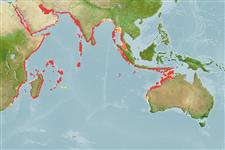>
Tetraodontiformes (Puffers and filefishes) >
Tetraodontidae (Puffers) > Canthigasterinae
Etymology: Canthigaster: Greek, kanthos = the outer or inner corner of the eye, where the lids meet, 1646 + Greek, gaster = stomach (Ref. 45335); cyanospilota: Named for its numerous small bright blue markings..
More on authors: Randall, Williams & Rocha.
Environment: milieu / climate zone / depth range / distribution range
Οικολογία
Θαλασσινό(ά) βενθικό(ς); εύρος βάθους 10 - 80 m (Ref. 90102). Subtropical
Indian Ocean: Indian Ocean to the Red Sea and Gulf of Aqaba.
Μέγεθος / Βάρος / Age
Maturity: Lm ? range ? - ? cm
Max length : 10.4 cm SL αρσενικό/απροσδιόριστο; (Ref. 83660)
Short description
Μορφολογία | Μορφομετρία
Μαλακές ραχιαίες ακτίνες (συνολικά): 9-11; Μαλακές εδρικές ακτίνες: 8 - 10; Σπόνδυλοι: 17. This species is distinguished by the following characters: Dorsal rays 9-11 (modally 9 in the Red Sea); anal rays 8-10 (modally 9); pectoral rays 15-17 (rarely 15); gill rakers 9-10; body depth between origins of dorsal and anal fins 3.15-3.6 in SL; head length (HL) 2.2-2.5 in SL; interorbital width 4.25-4.85 in HL: gill opening length 5.4-6.5 in HL; origin of anal fin below of posterior to rear base of dorsal fin, the preanal length 1.25-1.35 in SL; longest dorsal ray 2.6-2.95 in HL; preserved colour pale grey to pale tan with 3 oblique, saddle-like, brown bars on body, not extending below level of upper end of gill opening a broad dark brown band across posterior interorbital and anterior occiput; head and body dark brown dots and short lines, including ones radiating from eye and margins of brown saddles (also within saddles on Red Sea specimens); dark lines on snout behind mouth vertical; below base of pectoral fin, a dark brown spot; a midventral brown line on head and abdomen; fins pale yellowish; live color with dark dots and lines are bright blue, the caudal fin is conspicuously marked with longitudinal blue lines or rows of small blue spots and short lines, snout is often green dorsally (Ref. 83660).
Inhabits seaward reefs on sand-rubble bottoms in 10-80 m. Solitary (Ref. 90102).
Life cycle and mating behavior
Γεννητική Ωρίμανση | Αναπαραγωγή | Γεννοβολία | Αβγά | Γονιμότητα | Προνύμφες
Randall, J.E., J.T. Williams and L.A. Rocha, 2008. The Indo-Pacific tetraodontid fish Canthigaster coronata, a complex of three species. Smithiana, Publ. Aquatic Biodiv. Bull. 9:3-13. (Ref. 83660)
IUCN Red List Status (Ref. 130435)
Threat to humans
Harmless
Human uses
Περισσότερες πληροφορίες
Age/SizeΑύξησηLength-weightLength-lengthLength-frequenciesΜορφομετρίαΜορφολογίαΠρονύμφεςΔυναμική προνυμφώνΣτρατολόγησηΑφθονίαBRUVS
ΑναφορέςΥδατοκαλλιέργειεςΠροφίλ υδατοκαλλιέργειαςΣτελέχοιΓενετικήElectrophoresesΚληρονομικότηταΑσθένειεςΜεταποίησηNutrientsMass conversion
ΣυνεργάτεςΦωτογραφίεςStamps, Coins Misc.ΉχοιΣιγκουατέραΤαχύτηταΚολυμβητικός ΤύποςΕπιφάνεια βραγχίωνOtolithsΕγκέφαλοιΌραση
Εργαλεία
Special reports
Download XML
Διαδικτυακές πηγές
Estimates based on models
Preferred temperature (Ref.
123201): 24.2 - 29.3, mean 27.7 °C (based on 404 cells).
Phylogenetic diversity index (Ref.
82804): PD
50 = 0.5000 [Uniqueness, from 0.5 = low to 2.0 = high].
Bayesian length-weight: a=0.03631 (0.01554 - 0.08482), b=2.88 (2.69 - 3.07), in cm total length, based on LWR estimates for this Genus-body shape (Ref.
93245).
Τροφικό Επίπεδο (Ref.
69278): 3.1 ±0.4 se; based on size and trophs of closest relatives
Ελαστικότητα (Ref.
120179): Υψηλό, ελάχιστος χρόνος για διπλασιασμό πληθυσμού < 15 μήνες (Preliminary K or Fecundity.).
Fishing Vulnerability (Ref.
59153): Low vulnerability (10 of 100).
